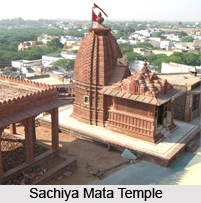 Sachiya Mata Temple, located at Osian, near the city of Jodhpur in the north-western Indian state of Rajasthan is an ancient temple which had been constructed between the 9th to 10th century C.E. Goddess Sachiya, also revered as `Sachayay Mata` or `Sachichiyay Mata` is the presiding deity of this temple. King Upendra, a ruler of the Parmar Dynasty had built this marvellous temple during his reign, to invoke the divine blessings of his `Kuldevi`. According to Hindu mythology, Sachiya Mata is the wife of Lord Indra, who is worshipped as the Rain God, which is the reason why she is also referred to as `Indrani`. This Goddess is generally worshipped by Parmar Rajputs, `Charans`, `Lakhesars Kumawat`, `Marwadi Maheshwari`, `Oswal`, `Pareeks` or Brahmins, `Kulthiya` families known as `Maid Kshatriya Swarnakar` and numerous other regional castes belonging to Madhya Pradesh, Rajasthan and other areas of northern India.
Sachiya Mata Temple, located at Osian, near the city of Jodhpur in the north-western Indian state of Rajasthan is an ancient temple which had been constructed between the 9th to 10th century C.E. Goddess Sachiya, also revered as `Sachayay Mata` or `Sachichiyay Mata` is the presiding deity of this temple. King Upendra, a ruler of the Parmar Dynasty had built this marvellous temple during his reign, to invoke the divine blessings of his `Kuldevi`. According to Hindu mythology, Sachiya Mata is the wife of Lord Indra, who is worshipped as the Rain God, which is the reason why she is also referred to as `Indrani`. This Goddess is generally worshipped by Parmar Rajputs, `Charans`, `Lakhesars Kumawat`, `Marwadi Maheshwari`, `Oswal`, `Pareeks` or Brahmins, `Kulthiya` families known as `Maid Kshatriya Swarnakar` and numerous other regional castes belonging to Madhya Pradesh, Rajasthan and other areas of northern India.
History of Sachiya Mata Temple
Hindu mythological accounts have revealed that Goddess Sachi was the daughter of King Pauloma, the Asura king who was reputed for his benevolence. The chief of his army, called `Vrut` or `Vritra` intended to marry Sachi. However, Sachi refused to establish matrimonial relationship with him. Aware of Sachi`s thoughts, Vrut resigned from the royal service and began worshipping Lord Shiva. Pleased by his devotion, Lord Shiva granted him a boon that no weapons would be capable of destroying him. Vrut then assembled a gigantic army and aimed to create a new kingdom whose area would exceed that of Pauloma`s territories. Lord Indra grew concerned and made attempts to protect the empire from Vrut. As Vrut was now immortal, due to the boon of Lord Shiva, Lord Indra realized that he would be unable to kill him with the aide of ordinary weapons. Therefore, Indra requested sage Dadhichi to lend him his bones, which were famous for their extraordinary toughness. Through self-sacrifice, Dadhichi offered his bones to Indra, who created a weapon with them, referred to as `Vajra`. On the battlefield, Indra fought against Vrut alone and defeated the latter with his Vajra. The condition laid by Indra was that Sachi would marry the victor, and she entered into wedlock with Indra, since he had won the battle.
There also exists a Jain mythological legend which traces the naming of the temple as Sachiya Mata. A Jain monk named Acharya Shrimad Vijay Ratnaprabhasuriji Maharaj Sahib had visited Osian to conduct `Anjan Salakha`, a religious ceremony inside the temple of Lord Mahavira in 43 C.E. Osian was known as `Upkeshpur` during that era and there existed a temple dedicated to Goddess Chamunda or `Jagat Bhavani` here. Male buffaloes were sacrificed at this temple to please the Goddess, in Navaratri festival. The Jain monk was deeply grieved upon learning about such a brutal animal sacrifice. Being compassionate, he was able to motivate the regional ruler and his minister to eliminate the evil practise of performing such a sacrifice. However, Goddess Chamunda was infuriated upon banning the sacrifice and punished the Jain monk. Eventually, the heart of the Goddess softened by the moral virtues against cruelty and she agreed that she would no longer accept any offering which symbolised blood. She blessed the monk and followers of Jainism. Ratnaprabhasuriji Maharaj Sahib then gave a new name to the Goddess, `Sachi Mata` or `Real Mother`, to Goddess Chamunda.
Architecture of Sachiya Mata Temple
There are two other shrines located within the premises of Sachiya Mata Temple which are dedicated to Amba Mata and Chandi Devi. It is believed that the construction of this majestic temple was accomplished in various stages. Beautifully carved arches are present at the entrance of Sachiya Mata Temple, which welcomes its visitors. Various kinds of impressions of Hindu Gods decorate the inner walls of this temple. A sculpture of `Varaha`, which is an incarnation of Lord Vishnu as a boar, exists on the northern walls of the temple. On the eastern walls, an image of Vishnu- Lakshmi is present. A stone slab on the western portion of Sachiya Mata Temple is embellished with several sculptures. Signs of medieval architecture are strewn across the interiors of the temple.
Currently, Sachiya Mata is worshipped with the aide of incense sticks, sandal, saffron and `lapsi` or an Indian sweet dish.



















